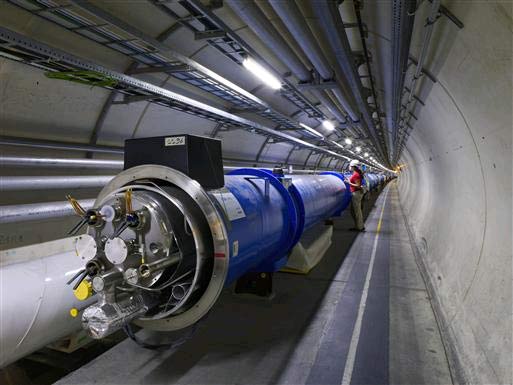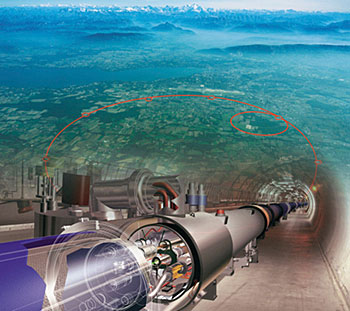Atom Smasher Could Be Used As Time Machine, Physicists Propose

In a 'long shot' theory, physicists propose that the world's largest atom smasher could be used as a time machine to send a special kind of matter backward in time.
The scientists outline a way to use the Large Hadron Collider (LHC), a 17-mile long (27-km) particle accelerator buried underground near Geneva, to send a hypothetical particle called the Higgs singlet to the past.
There are a lot of "ifs" to the conjecture, including the major question of whether or not the Higgs singlet even exists and could be created in the machine.
"Our theory is a long shot, but it doesn't violate any laws of physics or experimental constraints," physicist Tom Weiler of Vanderbilt University said in a statement.
However, if the theory proves correct, the researchers say the method could be used to send messages to the past or the future.
Weiler and Vanderbilt graduate fellow Chui Man Ho describe their idea in a paper posted March 7 on the research website arXiv.org.
Elusive Higgs
Sign up for the Live Science daily newsletter now
Get the world’s most fascinating discoveries delivered straight to your inbox.
The Higgs singlet is related to another theorized but not yet detected particle called the Higgs boson. This particle, and its related Higgs field, are thought to confer mass on all the other particles, and its discovery could help scientists answer the question, why do some particles have more mass than others?
The search for the Higgs boson was one of the main motivations for building the LHC in the first place. Since the atom smasher began regular operation last year, it has yet to find evidence of the Higgs boson, but the machine is still ramping up to its peak energies.

If the collider does succeed in producing a Higgs boson, some theories predict that it will create a Higgs singlet at the same time.
This particle may have a unique ability to jump out of the normal three dimensions of space and one dimension of time that we inhabit, and into a hidden dimension theorized to exist by some advanced physics models. By traveling through the hidden dimension, Higgs singlets could reenter our dimensions at a point forward or backward in time from when they exited.
"One of the attractive things about this approach to time travel is that it avoids all the big paradoxes," Weiler said. "Because time travel is limited to these special particles, it is not possible for a man to travel back in time and murder one of his parents before he himself is born, for example. However, if scientists could control the production of Higgs singlets, they might be able to send messages to the past or future."
M theory
The test of the researchers' theory will be whether the LHC shows evidence of Higgs singlet particles and their decay products spontaneously appearing. If it does, Weiler and Ho believe that they will have been produced by particles that travel back in time to appear before the collisions that produced them.
The theory is based on M-theory, a "theory of everything" that attempts to unite the forces of nature and describe everything in the universe. It's based on string theory, which posits that all particles are fundamentally made up of tiny vibrating strings.
Theoretical physicists have developed M-theory to the point that it can accommodate the properties of all the known subatomic particles and forces, including gravity, but it requires 10 or 11 dimensions instead of our familiar four. This has led to the suggestion that our universe may be like a four-dimensional membrane or "brane" floating in a multi-dimensional space-time called the "bulk."
According to this view, the basic building blocks of our universe are permanently stuck to the brane and cannot travel in other dimensions.
There are some exceptions, however. Some argue that gravity, for example, is weaker than other fundamental forces because it diffuses into other dimensions. Another possible exception is the proposed Higgs singlet, which responds to gravity but not to any of the other basic forces.










